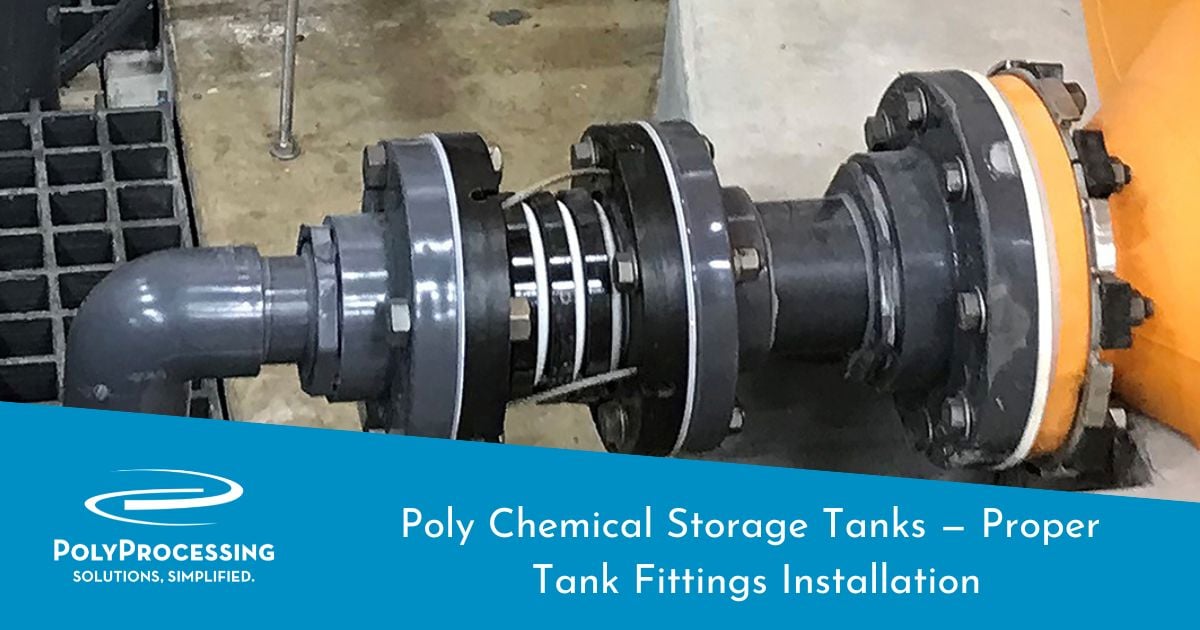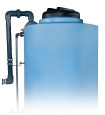Poly Chemical Storage Tanks - Proper Tank Fittings Installation
The proper installation of the various chemical storage tank fittings is important to ensure safe tank installation and operation. Here is a short outline of installation best practices for the various fittings of Poly Processing chemical storage tanks.
More detailed instructions can be found in Poly Processing’s Installation, Operation and Maintenance manual.

IMFO® Flange Fitting Assembly
Poly Processing assembles and hydro-tests the IMFO® (Integrally Molded Flanged Outlet) assembly to ensure a proper seal. DO NOT disassemble the factory installation. If a field replacement is required, follow the enlarged image in the Installation Technical Bulletin as a guide.
When storing, transporting, and installing the chemical storage tank, it’s important to protect the IMFO flanged nozzle from damage. When storing, the tank can be positioned upright with adequate blocking, or laid on its side and chocked to prevent rolling.
B.O.S.S. Fitting® Assembly
Refer to the B.O.S.S. Fitting Assembly manual in the Installation Technical Bulletin for drill bit sizes, installation steps, and torque wrench tightening settings. It’s vital to conduct a 24-hour hydro test before filling the tank with chemicals to test the gasket seals and fittings.
Bulkhead Fittings
Follow these installation steps for Bulkhead Fittings:
- Slide the gasket over the body of the fitting.
- From inside the tank, insert the fitting body into the hole in the tank sidewall.
- Apply the recommended thread tape (see below) on the fitting body and install the large nut on the outside of the tank.
- Hand tighten plus 1/4 turn with a wrench. Most Bulkhead fittings use left-hand threads.
- To prevent the gasket from creeping between the fitting and the tank wall, do not allow the fitting body to slip or spin when tightening.
- Inspect gasket for creep. If found, loosen the nut and perform steps 4 & 5 again.
- When installing a pipe or flange adapter into the BHF, do not allow BHF to slip and do not over tighten.
Finally, as with all the fittings, hydro-test the storage tank for a minimum of 24 hours before placing it into chemical service.
Below is a short video illustrating bulkhead fitting tightening.
Bolted Flange Fittings
Refer to the Bolted Flange Fittings link of the Installation manual for installation steps, and refer to the video below for proper torque tightening of the bolts. It’s important not to over tighten bolts to avoid damage to the flange and gasket. As with all the fittings, conduct a 24-hour hydro test before filling the tank with chemicals to test the gasket seals and fittings.
Stainless Steel Fittings
Follow the installation steps outlined for both Coupler and Full Nipple Stainless Steel fittings. These installation steps are outlined in the Installation, Operation and Maintenance manual. Drill bit sizes and wrench torque settings are specified for correct installation.
Self Aligning Universal Ball Dome Fittings
The Self Aligning Universal Ball Dome fittings are designed for use only on tank domes.
DO NOT USE ON THE SIDEWALL OF THE TANK!
There are two styles of Ball Dome fittings:
- Bulkhead Fitting Style
- Bolted Flange Style
NEVER stand on a tank dome when installing dome fittings. The surfaces are flexible and slippery and a fall could easily occur. Use portable ladders, scaffolding, or personnel lifts with proper fall protection.
Refer to the Installation Technical Bulletin under Self Aligning Universal Ball Dome Fittings for complete installation steps.
Bellows Transition Fitting
Poly Processing’s SAFE-Tank® is a "tank-within-a-tank" system that keeps contaminants from entering the interstitial area. These tanks provide secondary containment to avoid the damaging of equipment or property, loss of chemical, or injury to employees in the event of a chemical spill.
For this reason, it is crucial to follow proper installation and to perform each and every step outlined in the Installation Technical Bulletin and installation videos for the Bellows Transition Fitting.
WARNING: The SAFE-Tank system is designed to provide a minimum of 110% secondary containment. Once the transition fitting is installed, a leak in the inner tank will result in product collection between the inner and outer tank. If this product is not drained off prior to breaking the seals of the transition fitting, serious property damage, injury or death may occur. Great care must be taken to protect people and property when working with a transition fitting.
Each of these storage tank fittings includes detailed installation instructions when we ship the storage tank. In addition, for more information, detailed installation instructions for each fitting are outlined in the Poly Processing Storage Tank Fittings Installation Manuals and Videos.
IMPORTANT: Use the Right Thread Tape and Cement
No matter what Poly Processing fitting is being installed, it is crucial to use the right thread tape or PVC/CPVC cement for a proper seal.
One question we get quite often is what type of thread tape we recommend and what type of PVC/CPVC cement we recommend. We have had good success with Blue Monster PTFE Thread Tape and recommend it for threaded fittings. Make sure the thread tape is robust and designed for higher end applications.
For PVC/CPVC cement, we have had good success with WELD-ON 724 CPVC cement and WELD-ON C-65 Cleaner and recommend these products.
- March 11, 2024
- Topics: Fittings and Accessories
About Poly Processing
Posts By Topic
Tech Talk Podcast Episodes
Subscribe By Email
Recent Posts
- Maximizing Fill Efficiency: Selecting the Optimal Fill Line System
- Chemical Storage Tanks: A Quick Guide for End Users
- Popular Customization Options for Chemical Storage Tanks
- Understanding Flood Zones Under the IBC: Building Requirements and Insurance Implications
- Choosing Between Steel, Polyethylene, and Fiberglass Tanks: What You Need to Know
Tank Configurator

Find the recommended tank and system components for your chemical storage challenge.
Configure a Tank Package





